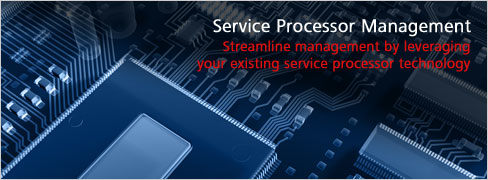Simplify Data Center Management with Centralized Control of Service Processors
Preventing Data Center downtime is a top priority for Data Center managers, and for good reason. Across every industry, lost hourly revenue due to downtime is very expensive. Recent studies estimate that downtime costs as much as $2.8M per hour in lost revenue for firms in the energy industry, more than $2M per hour for firms in telecommunications, and $1M -$1.6M per hour for companies in other sectors, including manufacturing, finance, and information technology.(1)
Even on good days, Data Center infrastructure management is a challenge, as administrators often have to control computer systems, serial devices, and power from multiple individual interfaces. Centralized server management platforms simplify access to IT assets by aggregating access and providing a single management portal, thus eliminating the need to manage devices individually.
When downtime occurs, centralized server management platforms provide a unified point of entry that allows administrators to access, troubleshoot, power cycle, and bring servers and appliances back online quickly. In addition, on a day-to-day basis, centralized management allows administrators to more easily and efficiently do their jobs.

Integrated Onboard Technologies
Integrated onboard technologies, or service processors, are microcontrollers embedded in a motherboard of a server, a PCI card, or on the chassis of a server. They are independent from the main CPU and the system OS and are accessible through an Ethernet interface; dedicated (Out-of-Band) or shared with the data Ethernet (Sideband).(2) Service processor features vary by manufacturer and include remote power-cycling of devices, monitoring of a server’s on-board instrumentation (temperature, CPU status, fan speed, and voltage), remote console access via Serial over LAN (SoL), and the ability to set event traps and perform OS-level shutdown.
Some service processors also allow for data logging, KVM control, and virtual media. There are several different types of integrated onboard technologies made by various manufacturers. Details about specific service processors can be found in Table 1 at the end of this article.
Centralized Management
There are currently two centralized management platforms on the market, Avocent’s DSView and Raritan’s Command Center, which can be used to manage devices made by multiple vendors. Avocent also makes two service processor aggregation appliances that can be used to manage devices with integrated onboard technologies: the Cyclades OnBoard Service Processor Manager and the MergePoint 5200 Management Gateway Appliance. Both integrate with the DSView software and can also be managed by CLI. The Cyclades OnBoard provides out-of-band physical consolidation, power control, and monitoring, and requires only one external IP address for all connected devices. The MergePoint provides service processor “auto discovery”; hardware monitoring, group execution of commands; integrated support for Remote Desktop Protocol (RDP) and Virtual Network Computing (VNC), and Serial over LAN (SoL) power control. Raritan, whose embedded solutions include PCI cards, industry-standard “daughter” cards, and a single-chip solution, currently supports generic devices through its Command Center Secure Gateway appliance and is expected to further expand this support to include IPMI in Q1. Minicom, whose KVM.net product currently provides out-of-band KVM over IP management for mixed server environments, is expected to add support for integrated onboard technologies in Q2.
Bringing Together A Total Solution
Both Avocent and Raritan provide complete integrated management solutions that allow administrators to manage devices with embedded onboard technologies such as IPMI, iLO, and DRAC, as well as allowing them to manage equipment currently controlled through secure console servers or KVM over IP. In addition, some devices can integrate support for Remote Desktop Protocol (RDP) and Virtual Network Computing (VNC), so that full server management coverage (in-band and out-of-band) can take place from one user interface. 42U’s knowledgeable sales engineers can provide you with a customized business-specific solution that will help you accomplish your goals.
Table 1: Integrated Onboard Technologies/Service Processors
| Manufacturer | Name | Description |
|---|---|---|
| Hewlett-Packard | iLO (integrated Lights-Out) | An intelligent management processor integrated on most ProLiant servers. Available in iLO Standard and iLO Advanced. iLO Standard provides basic system board management functions, diagnostics and essential “Lights-Out” functionality. iLO Advanced provides enhanced remote administration functionality with a license, including graphic remote console and virtual media. It also has increased security features such as integration with Microsoft Active Directory and Novell eDirectory and two-factor authentication. (3) |
| RILOE (Remote Insight Lights-Out Edition) | PCI cards that provide front-of-the-server remote management for ProLiant servers that do not have embedded Integrated Lights-Out technology. (4) | |
| Dell | DRAC (Dell Remote Access Card) | A systems management solution designed to provide remote management capabilities for Dell PowerEdge systems. (5) |
| IBM | RSA (Remote Supervisor Adapter) | Service processor on a PCI card that manages the Baseboard Management Controller (BMC). The SlimLine, a version of the RSA II, is an internal card that includes the BMC and uses a dedicated Ethernet connector on the server for communication. It also allows web-based management. (6) |
| Sun Microsystems | ALOM (Advanced Lights-Out Manager) | The standard system controller for remote out-of-band management for many current Sun servers. ALOM allows for monitoring, logging, alerting, and basic system control. It replaces the Remote System Control (RSC) used on VSP servers and Lights Out Management used on Sun Netra servers.(7) |
| ILOM (Integrated Lights-Out Manager) | A built-in system management tool that enables monitoring and management of the components installed in the Sun Blade 8000 Modular System Chassis. It is accessible through both web browser and command-line interfaces and supports the SNMP and IPMI management protocols. (8) | |
| RSC (Remote System Control) | Remote management and administration software for Sun Fire V480, Sun Fire V490, Sun Fire V880, and Sun Fire V890 servers that provides a graphical user interface (GUI) and command-line interface (CLI). (9) | |
| Multi-Vendor | IPMI (Intelligent Platform Management Interface) | An open standard service processor technology that provides a single service processor protocol for servers manufactured by different vendors. IPMI has been adopted by every major server platform vendor. (10) |
42U provides turnkey Data Center solutions, including KVM over IP, intelligent power, environmental monitoring, rack cooling, and rackmount solutions. The team at 42U specializes in assessing needs, creating solutions, and supporting clients, to ensure that IT professionals maximize their use of current technologies to improve overall business performance.
Read More about Data Center Management
References:
(1) IT Performance Engineering & Measurement Strategies: Quantifying Performance Loss, Meta Group, October 2000, cited in “The Hidden Cost of Computer Downtime,” http://www.creativedata.net/index.cfm?webid=207
(2) Service Processor Management http://www.global.avocent.com/us/learnmore/serviceprocessor.asp and Centralized Management http://www.avocent.com/web/en.nsf/Content/learnmoreDSV3
(3) HP Integrated Lights-Out (iLO) Standard http://h18013.www1.hp.com/products/servers/management/iloadv/index.html
(4) Remote Insight Lights-Out Edition II http://h18013.www1.hp.com/products/servers/management/riloe2/index.html
(5) Dell PowerEdge Remote Access Controller (DRAC) http://lists.us.dell.com/fom-serve/cache/75.html
(6) Service Processor Management http://www.global.avocent.com/us/learnmore/serviceprocessor.asp
(7) Sun Advanced Lights Out Manager 1.6 (ALOM) http://www.sun.com/servers/alom.html
(8) What Is ILOM? http://www.sun.com/products-n-solutions/hardware/docs/html/819-5846-11/819-5846-11/c~config_ilom.html
(9) Sun Remote System Control (RSC) for Sun Fire V480, Sun Fire V490, Sun Fire V880, and Sun Fire V890 Servers http://www.sun.com/servers/rsc.html
(10) Service Processor Management http://www.global.avocent.com/us/learnmore/serviceprocessor.asp




